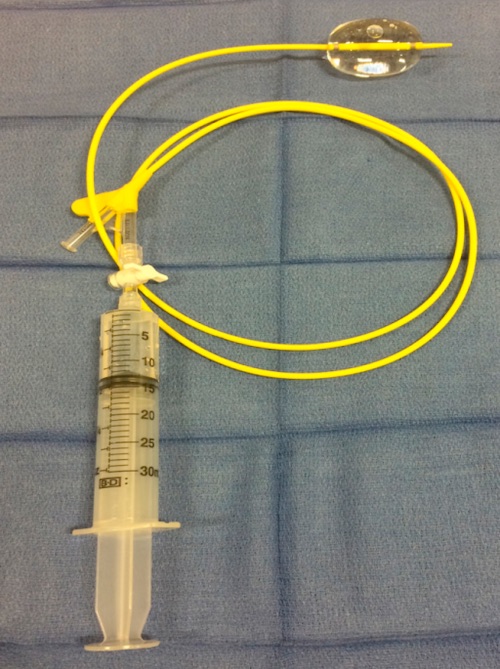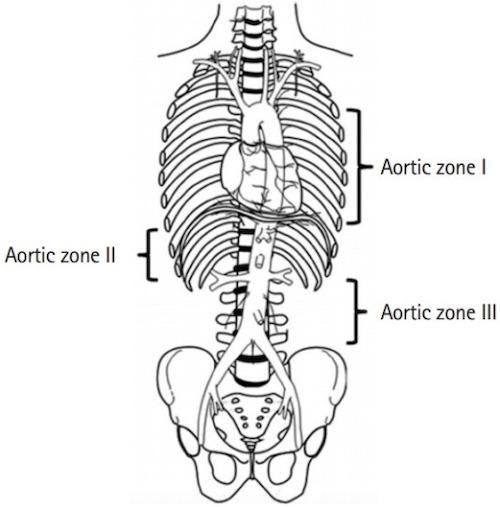Trauma: Resuscitative Endovascular Balloon Occlusion of the Aorta (REBOA)
Resuscitative Endovascular Balloon Occlusion of the Aorta (REBOA)
General
- A Balloon Occlusion Catheter Inserted Through the Femoral Artery Retrograde to Occlude the Aorta & Prevent Bleeding
- Less Physiologic Disturbance & Higher Success than Aortic Cross Clamping
- Overall Outcomes & Survival Unknown
- Serves as an Adjunct but Should Not Delay Definitive Repair (OR/IR)
Indications
- Poorly Defined & Evolving
- Generally: Abdominal or Pelvic Trauma in Hemorrhagic Shock
Contraindications
- Evidence of Neck or Thoracic Hemorrhage
- Bleeding is Exacerbated by Occlusion
- Penetrating Thoracic Trauma
- Cardiac Arrest When ED Thoracotomy is Indicated Instead

REBOA Catheter 1
Aortic Zones
- Zone I: Left Subclavian to Celiac Trunk
- Goal Zone for Intraabdominal or Retroperitoneal Hemorrhage
- Cause Mesenteric & Renal Ischemia
- Zone II: Celiac Trunk to Renal Arteries
- Never Inflate in Zone II – Cause Mesenteric & Renal Ischemia Which Can Be Avoided in Zone III
- Zone III: Renal Arteries to the Bifurcation
- Goal Zone for Pelvic Hemorrhage
Placement
- Access Common Femoral Artery (Similar to an Arterial Line)
- Measure & Mark Insertion Depth on Guidewire & Catheter
- Guidewire: Insertion to Sternal Angle via Umbilicus
- *Some Newer Catheters Do Not Require Guidewire
- Catheter:
- Zone I: Insertion to Xiphoid via Umbilicus or Simply to Sternal Notch
- Approximately 46 cm
- Zone III: Insertion to Umbilicus or Xiphoid Process
- Approximately 26 cm
- Zone I: Insertion to Xiphoid via Umbilicus or Simply to Sternal Notch
- Guidewire: Insertion to Sternal Angle via Umbilicus
- Insert Guidewire & Then Catheter
- Inflate Balloon to Moderate Resistance
- Use X-Ray to Confirm Placement
- Secure Catheter & Expediate OR/IR for Definitive Control
- *Always Note Insertion Length & Have a Person Dedicated to Manning the Catheter as Pulsation of Aorta Can Cause Migration
Complications
- Extremity Ischemia from Catheter
- Aortic Injury, Dissection or Perforation
- Embolization of Aortic Plaque
- Mesenteric Ischemia
- Ischemia-Reperfusion Injury
- Some Promote Intermittent or Partial Occlusion to Limit

Aortic Zones 2

XR Confirming REBOA Position 3
References
- Weltz AS, Harris DG, O’Neill NA, O’Meara LB, Brenner ML, Diaz JJ. The use of resuscitative endovascular balloon occlusion of the aorta to control hemorrhagic shock during video-assisted retroperitoneal debridement or infected necrotizing pancreatitis. Int J Surg Case Rep. 2015;13:15-8. (License: CC BY-NC-ND-4.0)
- Lee J, Kim K, Jo YH, Lee JH, Kim J, Chung H, Hwang JE. Use of resuscitative endovascular balloon occlusion of the aorta in a patient with gastrointestinal bleeding. Clin Exp Emerg Med. 2016 Mar 31;3(1):55-58. (License: CC BY-NC-3.0)